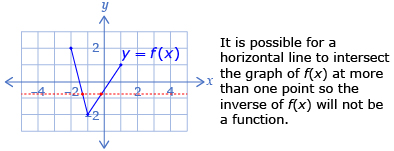The following example describes how to determine the inverse of a function, the domain and range of both relations, and whether the inverse is a function.
Read “Link the Ideas” and “Example 1” on pages 46 and 47 of the textbook.
In “Example 1” you saw that the inverse of a function may not be a function. When this is the case, function notation is not appropriate—that is, y = f −1(x) may not be an appropriate title for the inverse. In this case, the title “inverse of f(x)” may be used.
Just as you can check if a relation is a function by using the vertical line test, a horizontal line test can be used to determine if the inverse of a relation is a function. If it is possible for a horizontal line to cross the graph of a relation at more than one point, the inverse will not be a function.

![]()
Although the inverse of a function may not be a function, it is often possible to restrict the domain of the function so the inverse is a function. The following example explains how.
Read “Example 2” on page 48 of your textbook.